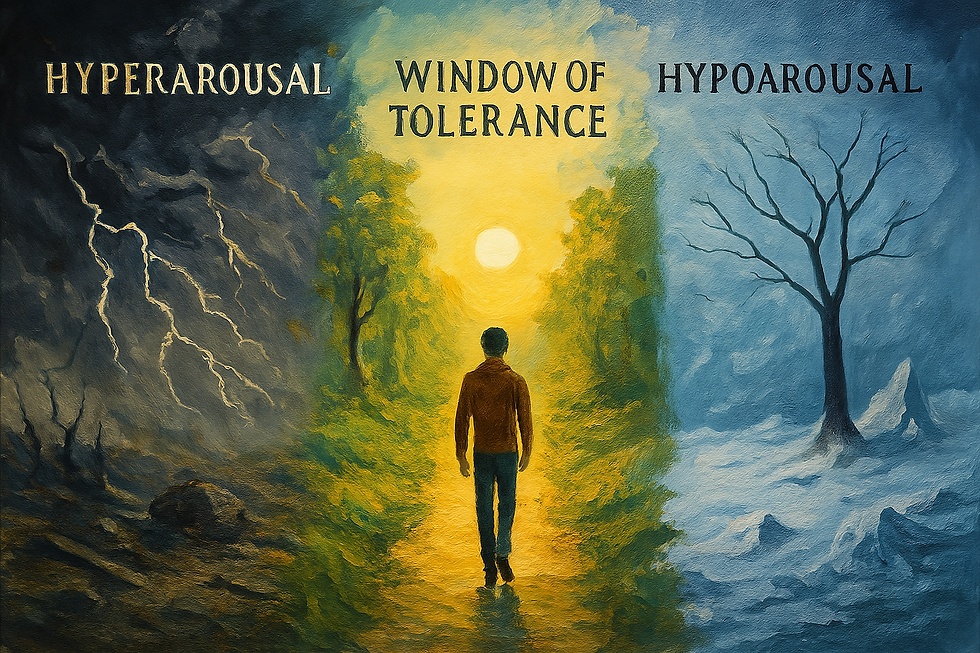Why Your ADHD Child “Loses It”—And What to Do Instead
- Aviva Ainbinder

- Mar 31
- 3 min read
Updated: Apr 1
If you’ve ever found yourself thinking:

“Why does my kid flip out over the smallest things?”
“Why do they completely shut down when I ask them to do something simple?”
You are not alone—and more importantly, your child isn’t broken.
They’re just outside their Window of Tolerance.
What Is the Window of Tolerance?
The Window of Tolerance is a concept developed by Dr. Dan Siegel, a leading expert in brain science and emotional regulation. It refers to the zone where a person’s nervous system can function well—feeling calm, alert, and emotionally balanced. When your child is inside their window, they can:
Focus
Think clearly
Communicate
Handle stress in a flexible way
In short, they can function like the version of them you know and love.
But when they’re pushed outside their window? Their brain goes into survival mode - just like being pushed out of a real window!
And that’s where things fall apart.
What Happens Outside the Window?
There are two main responses:

1. Hyperarousal – Fight or Flight
This might look like:
Yelling or screaming
Defiance or talking back
Restlessness or running away
Intense anxiety or meltdowns
2. Hypoarousal – Freeze
This might look like:
Zoning out
Going quiet or numb
Saying “I don’t care”
Looking exhausted or spaced out
In both cases, the thinking brain (prefrontal cortex) is offline. Your child isn’t being difficult on purpose—they’re dysregulated.
Why ADHD Makes the Window Narrower
Kids with ADHD often have a narrower window of tolerance than their peers. Their nervous systems are more reactive, more sensitive to external stimuli, and can often be overloaded by everyday demands.
That means:
A loud noise, confusing instructions, or a change in routine can push them into overload.
They shift from “okay” to “not okay” very quickly.
What looks like laziness or attitude is often their brain hitting the brakes—or the gas—because it’s overwhelmed.
So What Can You Do?
This part is important:
When your child is dysregulated, they need support, not correction.
Here are four ways to help them get back into their window of tolerance:

1. Stay calm and grounded yourself
Your calm nervous system helps regulate theirs. (Easier said than done—but it's powerful.)
2. Use sensory tools
Fidget toys, chewlery, weighted blankets, movement breaks—these all help bring the body back into regulation.
3. Offer connection
Sit close. Lower your voice. Validate their feelings. When they feel safe with you, their system starts to settle.
4. Press pause on teaching
Don’t try to lecture, reason, or discipline in the moment. Wait until they’re back in their window.
And for the Big Question: What About Parents with ADHD?
This applies to you, too. If you're also neurodivergent, your window might be narrower than you'd like—and that’s okay.
Start by building awareness around your own signs of hyperarousal (rage, panic, reactivity) and hypoarousal (shut down, avoidance, brain fog). Practice regulating yourself first—and not from a place of guilt, but from a place of power.
You don’t have to be a perfect parent. You just need to be a regulated one—most of the time.
Final Thoughts: The Shift That Changes Everything
The next time your child “loses it,” ask yourself: “Are they outside their window?
Then ask, "What can I do to help bring them back in?” Because:
Regulation comes before education. Connection comes before correction.
When you learn to parent through the lens of the nervous system, everything changes. You go from reacting to responding. From chaos… to connection.
Want help figuring out what dysregulation looks like in your home? Let’s talk. I help parents of ADHD kids build calmer homes—without having to be perfect. Just drop me a line on WhatsApp, and I will contact you.




Comments